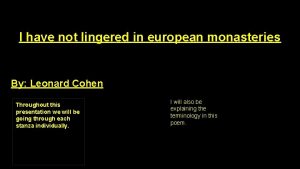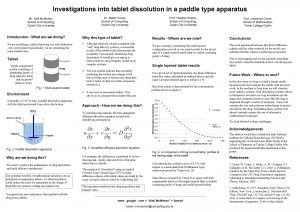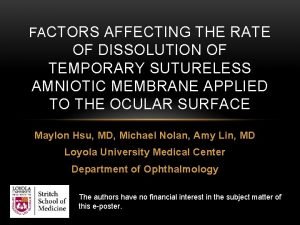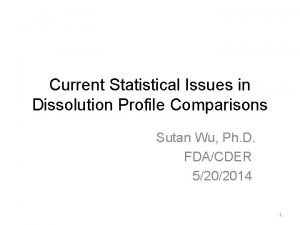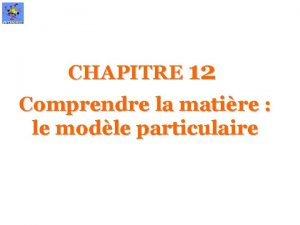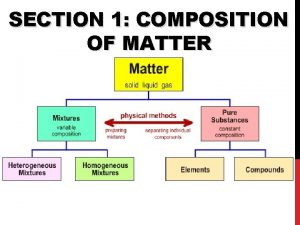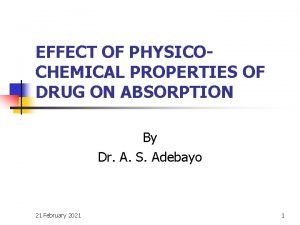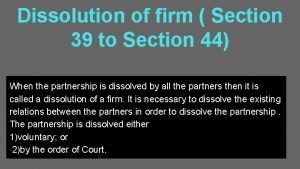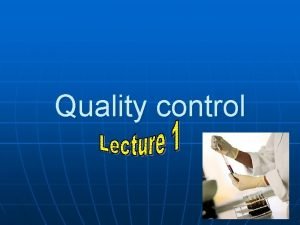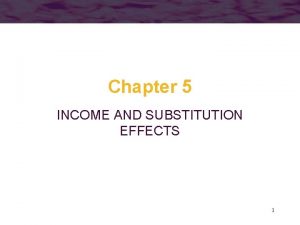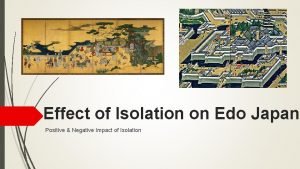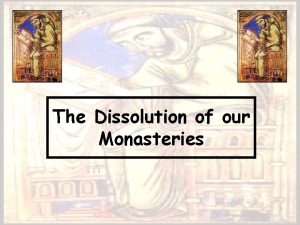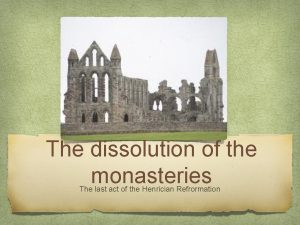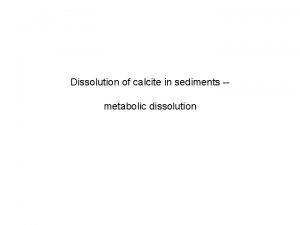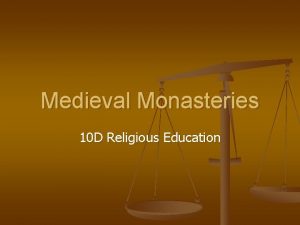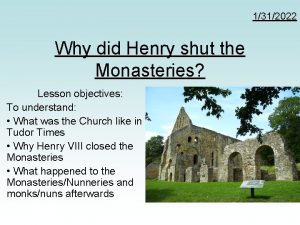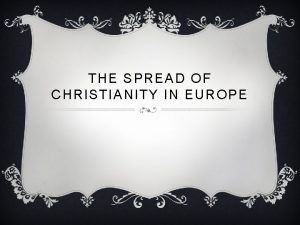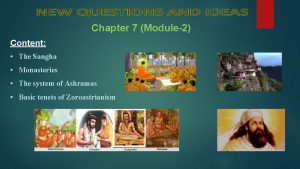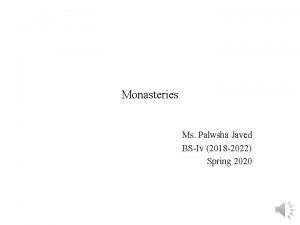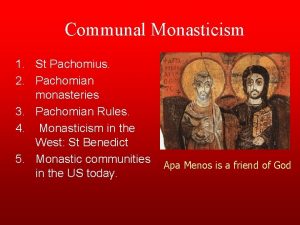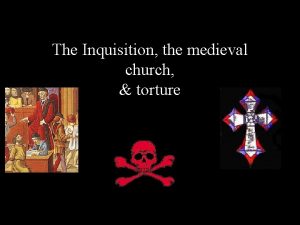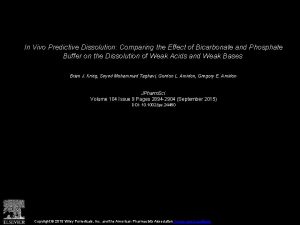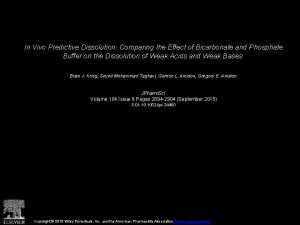What effect did The Dissolution of the Monasteries





























- Slides: 29

What effect did The Dissolution of the Monasteries have on society and culture? Key Stage 5: History Learning Aims and Outcomes • Students will use evidence to help in their understanding of the effects of the dissolution of the monasteries • Students will be able to demonstrate skills in assessing and using evidence, such as the creation of criteria Relates to: OCR - Unit Y 106: England 1485– 1558: the Early Tudors - The reign of Henry VIII after 1529 – The Dissolution of the Monasteries EDEXCEL - A 1 Henry VIII: Authority, Nation and Religion, 1509 -40 - The Dissolution of the Monasteries AQA - 2 D Religious conflict and the Church in England, c 1529–c 1570 - Change and reaction, 1536 – 1547 - The Dissolution of the Monasteries This Power. Point relates to the Teaching Activity: What effect did The Dissolution of the Monasteries have on society and culture?

The dissolution of the monasteries happened between 1536 and 1540; a remarkably short period of time. The buildings were abandoned and the monks dispersed. But how did it happen? What happened next? What effect did this have nationally and locally? Who gained and who lost out?

An aerial view of the remains of Roche Abbey, Maltby, South Yorkshire. This Cistercian Abbey was founded in 1147 and surrendered to the Crown in 1538. Photograph taken July 1999 © Copyright Historic England Archive ref: nmr 17292/28 There were over 800 monasteries before The Dissolution. All were eventually closed but suffered different fates. Each has a story to tell. . . Start by reading the story of what happened at Roche Abbey in Yorkshire.

A near contemporary account of ’the spoilation of Roche Abbey’ The following account is taken from the Cistercians in Yorkshire website and based on Michael Sherbrook's account of ‘the spoliation of Roche’. The original account is in the British Library reference; BL, Add. MS 5813, fo. 5, p. 1. For a transcription, see Tudor Treatises, ed. A. G. Dickens, YAS Rec. Ser. 125 (Wakefield, 1959), pp. 123 -126. Background Michael Sherbrook was rector of Wickersley, some five miles west of Roche, from 1567 - c 1610. He completed his account in the 1590 s, but may actually have begun writing around 1567. Sherbrook was himself a child at the time of the Dissolution, but recounts the memories of his father and uncle who witnessed at first hand the spoilation of Roche. Abbot Henry Cundall of Roche and his seventeen monks gathered in the chapterhouse at Roche for the last time on 23 June 1538, and signed the surrender deed, sealing the fate of their abbey. The keys of Roche were then handed over to the commissioners and an exhaustive inventory was taken of all the monks’ possessions and livestock, which were then claimed as Crown property. Each monk was granted a pension, the precise amount depending on his standing within the abbey. Every member of the community also received a ‘reward’. Abbot Henry was given an additional £ 30, as well as his books, a quarter of the abbey’s plate, cattle, household items, a chalice, vestment and a portion of corn, which was to be taken at his discretion. The other monks each received half a year’s allowance, and every servant of the abbey was given half a year’s wages. Following the dispersal of the monks, the abbey buildings were destroyed to ensure that the community would not attempt to reconvene.

The Account (Roche Abbey) a house of White Monks; a very finely built house of freestone and covered with lead (as the abbeys in England, as well as the churches are). An uncle of mine was present at the breaking up of the abbey, for he was well acquainted with several of the monks there. When the community was evicted from the abbey, one of the monks, his friend, told him that each monk had been given his cell where he slept, wherein there was nothing of value save his bed and apparel, which was simple and of little worth. This monk urged my uncle to buy something from him, but my uncle replied that he could see nothing that would be of any use to him; the monk asked him for two pennies for his cell door, which was worth over five shillings; his uncle refused, as he had no idea what he would do with a door (for he was a young unmarried man, and in need of neither a house nor a door). Others who came along later to buy the monks’ corn or hay found that all the doors were open, and the locks and shackles plucked off, or the door itself removed; they entered and stole what they liked. Some took the service-books that were in the church and laid them on their Waine Coppes (part of a cart) to repair them; some took windows from the hay barn and hid them in the hay, and did the same with other things: some pulled iron hooks out of the walls – but did not buy them – when the yeomen and gentlemen of the country had bought the timber of the church. For the church was the first thing that was spoiled; then the abbot’s lodging, the dormitory and refectory, with the cloister and all the buildings around, within the abbey walls. For nothing was spared except the ox-houses and swinecoates and other such houses or offices that stood outside the walls – these had greater favour shown to them than the church itself.

This was done on the instruction of Cromwell, as Fox reports in his Book of Acts and Monuments. It would have pitied any heart to see the tearing up of the lead, the plucking up of boards and throwing down of the rafters. And when the lead was torn off and cast down into the church and the tombs in the church were all broken (for in most abbeys various noblemen and women were buried, and in some kings, but their tombs were no more regarded than those of lesser persons, for to what end should they stand when the church over them was not spared for their cause) and all things of value were spoiled, plucked away or utterly defaced, those who cast the lead into fodders plucked up all the seats in the choir where the monks sat when they said service. These seats were like the seats in minsters; they were burned and the lead melted, although there was plenty of wood nearby, for the abbey stood among the woods and the rocks of stone. Pewter vessels were stolen away and hidden in the rocks, and it seemed that every person was intent upon filching and spoiling what he could. Even those who had been content to permit the monks’ worship and do great reverence at their matins, masses and services two days previously were no less happy to pilfer, which is strange, that they could one day think it to be the house of God and the next the house of the Devil – or else they would not have been so ready to have spoiled it. For the better proof of this, thirty years after the Suppression I asked my father, who had bought part of the timber of the church and all the timber in the steeple with the bell frame, (in the steeple eight or nine bells hung - the last but one could not be bought today for £ 20 – and I myself saw these bells hanging there over a year after the Suppression) if he thought well of the religious people and of the religion followed at that time? And he told me yes, for he saw no cause to the contrary: well, I said, then how did it come to pass that you were so ready to destroy and spoil the thing that you thought so well of? What should I have done, he asked, might not I as well as the others have had some profit from the spoils of the abbey? For I saw that everything would disappear and therefore I did as the others did. ’

Thus you may see that those who thought well of the religious, and those who thought otherwise, agreed enough to spoil them. Such a devil is covetousness and mammon! And such is the providence of God to punish sinners in making themselves instruments to punish themselves and all their posterity from generation to generation! For no doubt there have been millions of millions that have repented since, but all too late. And this is the extent of my knowledge relating to the fall of Roche Abbey. How does the account fit in? • These events relate to one particular monastery and accounts such as this are not available for all monasteries. However the events follow a general pattern that was repeated in most of the religious houses that were closed during the dissolution. • The account is of interest for the detail of what happened to the monks and to the buildings and also for the hints that are given as to why monasteries were not just closed but actively destroyed. • Moreover it gives us contemporary information which includes not just what happened but also throws light on how the people caught up in it felt about events. • This evidence can be used when considering the debate about the long and short term effects of the closure of the monasteries; to include local as well as national effects.

The account is long and detailed. Use the table below to create your own shorter step-by-step summary of it. Step 1 Step 2 Abbot Henry Cundall of Roche and his seventeen monks gather in the chapter-house at Roche on 23 June 1538, and sign the surrender deed.

What can you learn from this account about the intentions of Thomas Cromwell? What evidence does the account provide for the way that people regarded their local monastery and the Roman Catholic church? Is there anything that the account does not tell us?

Having investigated one site in detail we now need to compare this to other monasteries. Look at the information in the captions on the next slides to find out what happened to a selection of other monasteries after the Dissolution. Use this information to start filling in the table on the effects of dissolution - you will need to choose which category to put each effect in. The table is also available to download as Word file.

The effects of the dissolution of the monasteries on churches, cathedrals and monks (Cultural Effects – At the time) on the poor, sick, travellers and education (Social Effects – The Poor) on the gentry, large landowners and society (Social Effects – The Rich) on buildings/landscape/heritage (Cultural Effects – At the present)

Fountains Abbey, North Yorkshire Photograph taken August 1990 © Crown copyright. Historic England Archive ref: nmr 12018/24 An aerial view of Fountains Abbey. This Cistercian monastery was founded in 1132 by a group of monks from the Benedictine house of St Mary’s, York. They wanted to pursue a harsher and more disciplined way of monastic life. During the Middle Ages Fountains was one of the leading Cistercian monasteries. It gave help to a number of needy people who came to the abbey gates during the famine of 1194 -6. By the time of the Dissolution it was the richest Cistercian abbey in Britain, valued at £ 1115 18 s 2 d. It was closed in November 1539. The abbot and 30 monks all received pensions. Demolition began in 1540. The new owner, Sir Richard Gresham, stripped it of anything of value. Furnaces were built in the church to melt the lead from the roof and pipes. The fire was fed by timber from the screens and furnishings. He did not demolish all the buildings as he planned to convert them into a mansion. The grounds surrounding the ruin were landscaped during the 18 th century. It is now (2011) a World Heritage Site.

Bayham Old Abbey, Lamberhurst, Kent Photograph taken 1 st May 1992 © Skyscan Balloon Photography ref: K 930645 This aerial view shows the ruins of Bayham Abbey with New Bayham Abbey beyond. The original abbey of the Premonstratensians or White canons (monks) was founded in the early 13 th century. It sat right on the border of Kent and Sussex and had 2 gatehouses, one for each county. In 1525 the abbey was dissolved by Cardinal Wolsey to create funds for Wolsey's college foundations at Oxford and Ipswich. Around 1800 the ruins became a picturesque feature of the landscaped grounds of New Bayham Abbey based on the ideas of landscape designer Humphry Repton. This site is now (2011) in the care of English Heritage

Kirkstall Abbey, Kirkstall, West Yorkshire Photograph taken 1896 - 1920 © Reproduced by permission of Historic England Archive ref: AA 97/08058 Kirkstall Abbey was founded in 1152 by a community of Cistercian monks from Fountains Abbey. It gained its wealth from keeping sheep for the wool trade. Monastic life for the 31 monks came to an end in November 1540 when the abbey was surrendered to Henry VIII as part of the dissolution of the monasteries. Although a few buildings were cleared to ground level most were left standing and used for agricultural purposes. This is perhaps why Kirkstall is now the most complete set of Cistercian ruins in Britain. The church still stands to roof level. In the late 18 th and early 19 th centuries the road from Leeds to Skipton ran right through the nave! The abbey is now in the care of Leeds City Council (2011).

Thetford Priory, Abbey House Grounds, Thetford, Norfolk Photograph taken 11 April 2002 © Mr Derek E. Hull. Source Historic England Archive ref: 384666 These are the remains of The Cluniac Priory of Our Lady of Thetford. It was founded in 1103 -4 by Roger Bigod, on the south side of the river Little Ouse. It was dependent on Lewes priory until 1114. In 1114 it moved to its present site, on the north of the river. It was one of the largest and richest religious foundations in medieval East Anglia. It was also the burial place of the earls and dukes of Norfolk for 400 years. When, in 1536, the priory was threatened with suppression, the staunchly Catholic 3 rd Duke of Norfolk petitioned Henry VIII to convert it into a college of secular canons. He pointed out that he was preparing in the church not only his own tomb but also one for the king’s own illegitimate son, Henry Fitzroy, Duke of Richmond. But the duke’s petition failed, and on 16 February 1540 the last prior and 16 monks surrendered to the king’s commissioners. The remains of the earls and dukes were moved to Framlingham church, close to their family seat, Framlingham castle. This property is now in the care of English Heritage (2010).

Glastonbury Abbey, Glastonbury, Somerset Photograph taken 26 June 2001 © David Sanderson. Source Historic England Archive ref: 265970 Glastonbury is by tradition the oldest monastic foundation in England. It is believed to contain the burial place of King Arthur. Little is known of the monastery until 940 when it was refounded as a Benedictine Abbey by St Dunstan. The standing remains belong to the great abbey church rebuilt after a disastrous fire in 1184. The abbey was dissolved in 1539 after the abbot Richard Whyting and 2 of his monks had been executed on top of Glastonbury Tor for alleged treason. This view shows the ruins of St Mary's Chapel with the walls supported with props to stop them from falling down.

Furness Abbey, Barrow in Furness, Cumbria Photograph taken 30 April 2001 © Mr CJ Wright. Source Historic England Archive ref: 388372 An St Mary of Furness was founded in 1123 by Stephen who became King of England. By Tudor times it was the second richest Cistercian house in England. The surrender of Furness abbey in 1537 was a turning point in the dissolution. The abbot and monks gave some support to the Pilgrimage of Grace, speaking out against the King. They were afraid that they might be executed and so decided to surrender the abbey voluntarily. This then became the pattern for other monasteries and made it easier to close them quickly. In 1539 the abbey and its land was granted to Henry VIII's first minister, Thomas Cromwell. In 1923 the abbey was put into the care of the Office of Works by the Cavendish family. It is now in the care of English Heritage (2010).

Malmesbury Abbey, Malmesbury, Wiltshire Photograph taken 07 September 1999 © Mr G Williams. Source Historic England Archive ref: 460896 A nunnery was first documented here in 603. A monastery was founded during the abbacy of Aldhelm (c 675 -705). It became Benedictine in the reign of Edgar (959– 975) and remained so until dissolved in 1539. The final Abbey Church was built circa 1160 -70 and had 13 th/14 th and 15 th century additions. The 431 feet (131 m) tall spire, collapsed in a storm around 1500. The west tower fell around 1550. As a result of these two collapses, less than half of the original building stands today. The abbey was closed at the Dissolution of the Monasteries in 1539 by Henry VIII. It was sold, with all its lands, to William Stumpe, a rich merchant. He gave the abbey church to the town for continuing use as a parish church and filled the abbey buildings with twenty looms for his cloth-weaving enterprise.

Priory of St Pancras, Lewes, East Sussex Photograph taken 10 April 2005 © Mr Trevor Hope. Source Historic England Archive ref: 293053 These are the ruins of the Priory of St Pancras. The priory was founded after 1077 by William de Warenne, the 1 st Earl of Surrey. The site was purchased after the dissolution by King Henry VIII's chief minister, Thomas Cromwell. In 1537 -38 he had it professionally dismantled by a team of men brought in from London.

Cathedral Church of St Augustine, Bristol Photograph taken August 1990 © Crown copyright. Historic England Archive ref: nmr 12018/24 The Cathedral was originally known as St Augustine's Abbey. It was founded in 1140 by Robert Fitzhardinge, a Bristol burgess. The main part of the church dates from the 14 th century. It is one of the earliest major hall churches, 'superior to anything else built in England indeed in Europe at the same time' (Pevsner). This type of church is much more common on the continent. In this type of church the Nave, Choir and Aisles are all the same height, making a large hall. In 1542 it was one of the 6 monastery churches designated as Cathedrals by Henry VIII after the dissolution. The others were, Chester, Gloucester, Oxford, Peterborough and Westminster.

Reconstruction Drawing of Hailes Abbey, Gloucestershire Photograph taken 1992 © Copyright Historic England Archive ref: j 950135 The Cistercian abbey of Hailes was founded in 1246 by Richard, Earl of Cornwall. He founded it in thanksgiving for surviving a shipwreck. Its elaborate buildings were funded by pilgrims visiting its relic, the 'Holy Blood of Hailes', a phial allegedly of Christ's blood. The abbey church was built by 1277. Following its dissolution in 1539 by Henry VIII, the abbey was sold to a dealer in monastic properties, soon after which the church was demolished. This site is now in the care of English Heritage (2010).

Reading Abbey Ruins, Reading, Berkshire Photograph taken 18 April 2001 © Ms Pamela Jackson LRPS. Source Historic England Archive. NM ref: 38934 This Cluniac Abbey was founded in 1121 by Henry I and was his favourite monastery. He was buried here. Reading was the only Cluniac house to be granted abbey status. It became benedictine in the 13 th century. I t was suppressed in 1539 during the Dissolution. Most of the stone has been removed since the dissolution. Much of it can be found built into walls all over Reading and several cart-loads of carved stones are in the Forbury Gardens near by.

Newstead Abbey, Ravenshead, Notts. Photograph taken September 2007 © Copyright Historic England Archive ref: dp 046153 An Augustinian Priory was established circa 1170 by Henry III. It was extended and rebuilt in the late 13 th century with the Prior's Lodgings, Great Hall and Dorter added in the 15 th century. The monastery was dissolved in 1539. In the following year Henry VIII granted Newstead to Sir John Byron. He converted the priory into a country house for his family. The poet, Lord Byron, inherited the house in 1798. Newstead was then sold to the Nottinghamshire philanthropist Sir Julien Cahn. He presented it to Nottingham Corporation in 1931. Many of the monastic buildings survive intact in the adjoining mansion which is used as a museum.

Abbey of St Agatha, Easby, North Yorkshire Photograph taken 27 June 2002 © Mr Alan Bradley LRPS. Source Historic England Archive ref: 322105 These are the standing remains of the Premonstratensian Abbey of St Agatha at Easby. The abbey was founded by Roald, Constable of Richmond Castle in 1155. There was also a hospital attached to the abbey for 22 poor men. Easby was closed in 1536 as part of the Suppression of the Monasteries, the abbey and its lands were let to Lord Scrope of Bolton for £ 300. At this time much of the north was rising in support of the monasteries, in what became known as the Pilgrimage of Grace, and Richmond was a major centre of the uprising. In December 1536 the town’s bailiffs restored the canons to Easby. However the pilgrimage failed and the abbey was soon returned to Lord Scrope. By 1538 most of the buildings had been stripped of their lead roofing and partly demolished. It seems surprising that the Scropes should have agreed to, or actually ordered, the demolition of the church, which was their family’s burial place. It is possible that the church was destroyed by royal order to prevent the monks from returning again. After its suppression in 1536 the buildings rapidly lapsed into ruin, before becoming an object of interest for antiquarians and Romantic artists in the 18 th and 19 th centuries. This site is now in the care of English Heritage (2010).

Birkenhead Priory, Birkenhead, Merseyside Photograph taken August 1990 © Crown copyright. Historic England Archive ref: nmr 12018/24 The Priory was founded in 1150 by Hamo de Massey as a Benedictine House for sixteen Benedictine (Black) monks and built in several phases up to 1400. It was sited on an isolated headland on the Wirral, bounded by Wallasey Pool, the Mersey Estuary and Tranmere Pool. It is now surrounded by shipyard dry docks. The priory served as accommodation for travellers using the ferry across the River Mersey. It was dissolved in 1536 and the estate passed into the hands of Ralph Worsley of Lancashire. After the buildings fell into ruins, the chapter house chapel survived as a place of worship. Services were later held in the adjoining St Mary's parish church. The remains were restored in 1896 when they became the property of Birkenhead Corporation.

Your table will look something like this, but with even more examples on churches, cathedrals and monks (Cultural Effects – At the time) on the poor, sick, travellers and education (Social Effects – The Poor) Six new cathedrals were created Monasteries no longer provided accommodation for travellers on the gentry, large landowners and society (Social Effects – The Rich) on buildings/landscape/heritage (Cultural Effects – At the present) Many younger sons of the gentry were able to buy property Many monasteries became ruins and are now tourist attractions

Look through your tables and discuss as a class or group what effects it is quite easy to find evidence about and which are more difficult. Why is this? For each category think about what effect that outcome would have had on the local area and nationally; short and long term, who were the winners and losers? Historians have long debated the effects of the closure of monasteries on society. Older, often Catholic, historians believed that the dissolution lead to increased unemployment and poverty and ultimately to the creation of the Elizabethan Poor Law. Contemporary historians disagree arguing that the closure of monasteries may have made some problems worse but did not create them. Can you use evidence from your table to decide who you agree with? Is there anything else we would need to know?

Extension work 1 Further questions for discussion or essay writing: • What determined the fate of individual monasteries? • Can this information tell us more about why the dissolution met with little or no local opposition?

Extension work 2 Choose one or two local monasteries and look at what happened to them in detail - use the information as a case study. How typical is the pattern of dissolution? What were the effects in that locality? How does this fit in with the historical debate on the effects of dissolution? Use this website find out about using archive sources to study an individual monastery. The National Archives - The Dissolution of the Monasteries and Chantries Alternatively you can find very detailed information on the dissolution of 5 monasteries on this website Cistercians in Yorkshire
 Leonard cohen monastery
Leonard cohen monastery Solubility and molarity relationship
Solubility and molarity relationship Section 26 of partnership act
Section 26 of partnership act Garner vs murray rule example
Garner vs murray rule example Awareness exploration expansion commitment dissolution
Awareness exploration expansion commitment dissolution Paddle type dissolution apparatus
Paddle type dissolution apparatus Maylon hsu md
Maylon hsu md Pharma test dissolution apparatus
Pharma test dissolution apparatus Dissolution
Dissolution Dentocult lb test
Dentocult lb test Lactobacillus colony count test
Lactobacillus colony count test Dissolution vs disintegration
Dissolution vs disintegration Dissolution of partnership
Dissolution of partnership Awareness exploration expansion commitment dissolution
Awareness exploration expansion commitment dissolution Bootstrap dissolution comparison
Bootstrap dissolution comparison Modèle particulaire dissolution
Modèle particulaire dissolution Composition of matter section 1
Composition of matter section 1 Noyes whitney equation
Noyes whitney equation Fosdick calcium dissolution test
Fosdick calcium dissolution test Dissolution on the happening of certain contingencies
Dissolution on the happening of certain contingencies Rate of dissolution
Rate of dissolution Difference between disintegration and dissolution
Difference between disintegration and dissolution Awareness exploration expansion commitment dissolution
Awareness exploration expansion commitment dissolution Chloride shift
Chloride shift Founder effect vs bottleneck effect
Founder effect vs bottleneck effect Marshallian demand function
Marshallian demand function Did isolation have a positive or negative effect on japan
Did isolation have a positive or negative effect on japan Hình ảnh bộ gõ cơ thể búng tay
Hình ảnh bộ gõ cơ thể búng tay Slidetodoc
Slidetodoc Bổ thể
Bổ thể
